Konĕpruské jeskyně
Koneprusy Caves
Useful Information
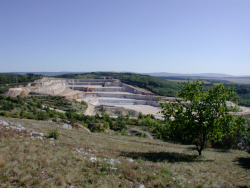
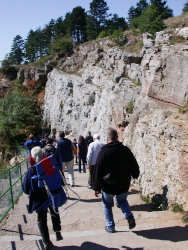
| Location: |
3 km west of Srbsko and 6 km from the town of Beroun.
Difficult to miss due to the large white lettering on the side of the hill. The entrance to the cave is in the quarry on Zlaty kun Hill. (49.9151649, 14.0675178) |
| Open: |
APR to JUN daily 8:30-16. JUL to AUG daily 8:30-17. SEP to OCT daily 8:30-16. NOV Mon-Fri 9, 11, 14. [2025] |
| Fee: |
Adults CZK 220, Children (3-15) CZK 120, Children (0-2) free, Students (-26) CZK 180, Disabled CZK 180, Seniors (65+) CZK 180. [2025] |
| Classification: |
 Karst Cave Karst Cave
|
| Light: |
 Incandescent Incandescent
|
| Dimension: | L=2,050 m, D=76 m, T=7.5-9 °C, H=96-100 %. |
| Guided tours: |
D=60 min, L=620 m, St=483, Max=45. V=125,000/a [2000] V=95,000/a [2023] |
| Photography: | allowed, no flash, selfie stick or tripod |
| Accessibility: | no |
| Bibliography: |
Kay Prüfer, Cosimo Posth et. al. (2021):
A genome sequence from a modern human skull over 45,000 years old from Zlatý kůň in Czechia
Nature Ecology & Evolution. 5 (6), June 2021: pp 820–825.
ISSN 2397-334X. PMC 8175239.
online
DOI
Ivo Chlupáč (1995): Ein Riff des Unterdevon bei Koneprusy In: Werner K. Weidert: Klassische Fundstellen der Paläontologie. Bd.3. Goldschneck Verlag. S.27-37. 
U. Flick (1996): Trilobiten aus dem Barrandium - Funde von der VFMG-Tagung in Prag 1994 Aufschluss, Jg.47, Nr.5, S.227-34. 
R.J. Prokop, V. Petr (1996) Kuzbassocrinus cf. bystrowi Yeltyschewa, 1957 (Crinoidea, col.) from the lower Devonian Koněprusy Limestone of the Barrandian area (Czech Republic) J. Czech Geol. Soc., 41 (3-4) 220-21. Andreas May (2002): Bisher noch nicht bekannte Stromatoporen aus dem Pragium (Unterdevon) von Koneprusy (Böhmen), Coral Research Bulletin, vol. 7: p. 115-140, 2 figs., 1 tabs., pl. 1-3; Dresden. researchgate 
Fritz Seemann (1907): Das Mittelbohmische Obersilur- und Devongebiet Südwestlich der Beraun, Beiträge zur Paläontologie Österreich-Ungarns, Bd. XX., 1907. pdf pdf |
| Address: |
Správa Konĕpruské jeskyně, Beroun, Koněprusy 101, 26601 Beroun, Tel: +420-730-572-485, Tel: +420-311-622-405.
E-mail: |
| As far as we know this information was accurate when it was published (see years in brackets), but may have changed since then. Please check rates and details directly with the companies in question if you need more recent info. |
|
History
| 1950 | discovered. |
| 1959 | opened to the public. |
Description
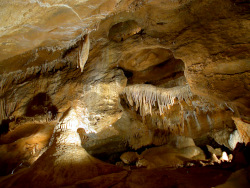
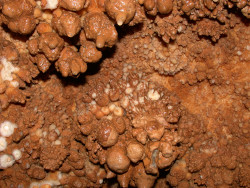
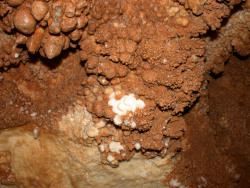

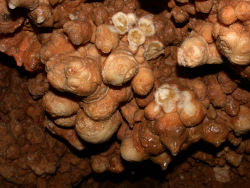
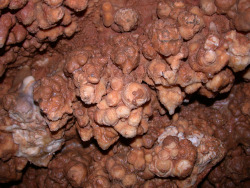
Konĕpruské jeskyně is located in Central Bohemia, 7 km South of Beroun. This is the biggest cave of Czechias second most important karst area which is called Český kras (Czech Karst) and the only show cave in this area. Located close to the capital Prague, only about 20 km to the southwest, it is also an important day trip destination. The cave is located at the rim of a huge open cast limestone quarry, the view from the cave entrance is breathtaking. The cave is reached on narrow roads from Beroun, located between the towns it has a large parking lot. Until recently it had almost no infrastructure except the ticket office and a small souvenir shop. However, the cave administration has erected an impressive new entrance building with brown and black wood panelling and a flat roof. This building was named Dům přírody Českého krasu (The Czech Karst House of Nature) and is a sort ofVisitor Center. It contains an exhibition about the whole area, the karst the flora and fauna, and the geological background. The cave is located in the Zlatý kůň (Golden Horse Hill, 475 m asl) and also named Zlatý kůň (Golden Horse).
The cave is of an impressive character, almost lacking any speleothems, the main hall is really wide, but only about 1.50 m high and tilted about 45°. This means the path, while crossing the huge chamber, always goes up and down stairs on the roof-like floor. And the path is always cut into the soft dark brown clay on the floor, to be high enough to stand comfortably. The surrounding limestone is 400-million-year-old Middle Devonian limestone. The crinoidal limestone is very rich in fossils, for example trilobites. There are a few speleothems in one section close to the entrance. Later there are two section with unique bulbous calcite. They resemble opal, nevertheless these are calcite speleothems, not quartz.
The cave also has numerous palaeontological remains, between 200,000 and 300,000 years old, but so far they were not exhibited. The findings included mastodon, sabre-toothed cat, monkey, cave bear, deer, reindeer, cave lion, woolly rhino, wolf, beaver, hyena and horse. Also, the fossilized bones of prehistoric humans where found, which were dated 45,000 BP. There were stone tools and decorative objects. The genome was analyzed, and it was a population that appears to have contributed genetically neither to later Europeans nor to Asians. We hope there will be a small exhibit in the new House of Nature.
Close to the exit in the upper part of the cave there was once the workshop of money forgers, which is dubbed The Mint. They used the cave during the 15th century, most likely from 1460 to 1470, as a secret place for their illegal activities. The produced Hussite coins bearing the symbol of the Czech lion. Instead of silver they used copper thinly plated with silver amalgam. As the worth depended on the metal at that time, they were obviously worthless. It seems they left one time and never returned, their equipment is more or less unchanged, the work not completed. Its unclear if they got caught or had an accident. There are no historic documents telling about forgers in the area, so there was obviously no trial.
The tours are made in Czech language only. The guides are local youths, and as they learn English at school, it’s normally possible to ask questions in English. The official text of the tour is available in different languages on paper, at least English and German. The paper is coated in plastic because of the humid cave, and there is a small deposit, which is returned when you bring back the text. There is also an app for the smartphone, offering Czech, English and German explanations for free. Please bring earphones for the audiotour. The application is provided by the show cave administration and works for most show caves in the country. Load the app and the audiofiles before you visit the cave, as it is actually in the middle of nowhere, mobile internet is poor and there is no wifi at the entrance.
We heard that the cave offers flashlight-only tours, which means the light is turned off and the visitor get torches. Those tours are offered only on the last Monday of the month between APR and OCT. We found this offer on an independent webpage, but it was not mentioned on their official webpage any more, so there is a chance they were discontinued. Contact them directly for recent info.
The area is quite popular with mineral and fossil collectors, there are numerous spots where it is possible to collect in abandoned quarries. However, be careful as several of them are now under Nature Protection, including all caves in the area. Others are privately owned and collecting is trespassing. Collecting is allowed in the Houba quarry, in other operating quarries after appointment with the operator.
Discovered in 1950, the cave shot to fame with the discovery of a forger’s den which had been left untouched since the fifteenth century. Finds included a set of weights, miners’ lamps, coin making equipment, moulds etc and even the remains of the last meal. Other finds included the abundant remains of Pleistocene fauna and pre-historic man, bones, and stone implements of the Szeletian culture. The lower series is a pleasant stalactite cave.
Text by Tony Oldham (2002). With kind permission.
- See also
 Member of the International Show Caves Association (ISCA)
Member of the International Show Caves Association (ISCA) Search DuckDuckGo for "Koneprusy Cave"
Search DuckDuckGo for "Koneprusy Cave" Google Earth Placemark
Google Earth Placemark OpenStreetMap
OpenStreetMap Koněprusy Caves - Wikipedia (visited: 07-MAY-2025)
Koněprusy Caves - Wikipedia (visited: 07-MAY-2025) Koněprusy (Koněpruské) Caves, official website (visited: 07-MAY-2025)
Koněprusy (Koněpruské) Caves, official website (visited: 07-MAY-2025) The Czech Karst House of Nature (visited: 06-MAY-2025)
The Czech Karst House of Nature (visited: 06-MAY-2025) Koněprusy caves (Non-official webpage) (visited: 07-MAY-2025)
Koněprusy caves (Non-official webpage) (visited: 07-MAY-2025) Konieprus (Koněprusy) - Mineralienatlas - Fossilienatlas (visited: 07-MAY-2025)
Konieprus (Koněprusy) - Mineralienatlas - Fossilienatlas (visited: 07-MAY-2025)
 Index
Index Topics
Topics Hierarchical
Hierarchical Countries
Countries Maps
Maps